flat72.jpg)

 Caspian Basin Issues This section contains several articles: Caspian Sea Legal Status, 2001 Theodore Jonas To obtain the following articles, please contact USACC Caspian Sea Legal Status A practical regime for the use and development of Caspian resources Theodore Jonas, Partner, Baker Botts L.L.P. Uncertainty surrounding the legal regime that will eventually govern the development and export of hydrocarbons from the Caspian Sea is one of several risk factors that investors have had to consider in doing business in the region. Despite recent setbacks, however, there are signs that the clouds are beginning to clear. Each of the five countries that share the Caspian shore knows that future prosperity depends on their collective ability to resolve the complex legal dispute over mineral and territorial rights in the Caspian Sea. World's Largest...Lake?
In the 19th century, ships of the Russian and Persian Empires ruled the Caspian, but their captains were interested in the sea as a trade route and a source of food -- not for the wealth of minerals beneath it. After several wars, Russia and Persia (present-day Iran) signed treaties to fix the land borders between them and to regulate use of the Caspian. New treaties in 1921 and 1935 established a 10-mile exclusive fishing zone for each country, and a 1940 agreement referred to the Caspian as the "Soviet-Iranian Sea," yet none of the treaties addressed mineral rights to the seabed. That wasn't a problem before 1991 when all of the countries around the edge of the Caspian, except Iran, were republics of the Soviet Union. After the breakup of the Soviet Union, however, Russia, Kazakhstan, Azerbaijan and Turkmenistan became independent -- and each new Caspian state wanted its share.
Why the Caspian is Important
As new fields are developed, the Caspian will become an important transit route for oil and gas exports from the region -- and that volume could be huge. Estimates of Caspian area reserves range from 179 billion to 195 billion oil-equivalent barrels. Peaceful development of the sea, and the rational governance of it, are essential to economic development around the Caspian. This is especially true for the developing economies of Azerbaijan, Kazakhstan and Turkmenistan.
The Law of the Seas
UNCLOS is an important document because it represents the best collective wisdom on laws to govern waters that are shared by two or more states. It takes into account centuries of rules developed to control international navigation, maritime borders, and the use of ocean resources. The Convention also addresses the role of modern technology, environmental concerns, and the need to resolve disputes in a peaceful, orderly way.
Why the Caspian is Different
The Caspian is not an "enclosed sea" under UNCLOS because, for centuries, the countries around it have exercised exclusive control over its use. The Caspian has no internationally navigable outlet. Although five major rivers and more than a hundred minor ones drain into it, the Caspian has no contact with the world's oceans. Its only navigable outlets are the Volga River, and a series of canals and rivers extending to the Black and Baltic Seas. These, however, are long inland Russian waterways, unusable without Russia's permission. On the other hand, the Caspian cannot be easily characterized as an "international lake," completely free of the international rules governing seas. It bears the oceanographic characteristics of a sea, and the number of states surrounding it make agreement on the use of its resources and the boundaries crossing it considerably more difficult than, say, the Great Lakes between Canada and the United States. Accordingly, it is appropriate in some respects to view the Caspian as a sea subject to the international laws of the sea. "Sea or lake, what difference does it make?" to borrow the words of one commentator (Bernard Oxman, Caspian Crossroads Magazine, Winter 1996). Building on the solid UNCLOS framework, a hybrid legal model that works can be constructed, regardless of how the Caspian is classified.
Applying the Law of the Seas to the Caspian
Iran started from the position that the Caspian should be treated as an international "condominium," with each of the five littoral states holding an undivided 20 percent share in its resources. That suited Iran, because a simple division of the sea into national sectors based on the shoreline they control would give Iran the smallest share, the deepest water, and the most speculative areas to drill. Other Caspian states forced the issue by proceeding to develop hydrocarbon resources on their own within the zones they would most likely get if the seabed was eventually divided. Backing away from the condominium idea, Iran then said it would accept a territorial division of the sea, but only if it got a 20 percent share. Meanwhile, Russia argued that the treaties between the former Soviet Union and Iran should continue to govern the Caspian. This was particularly unhelpful in light of the fact that those treaties did not address the interests of the three newly created states, nor did they address mining the seabed. In the mid-1990s Russia shifted its position to the establishment of 45-mile Exclusive Economic Zones along the shores of the littoral states, with the center of the Caspian being subject to joint development by the five states. Russia changed its position again in 1998 when it signed an agreement with Kazakhstan to divide the seabed along a median line without leaving a common development zone. Russia later signed a communiqué with Azerbaijan based on the same principles: a division of the seabed into national sectors along a modified median line, leaving no common zone for joint development. Since 1991, Azerbaijan and Kazakhstan have consistently maintained that the seabed should be divided into national sectors along a median line -- although they have had some differences over joint fishing and navigation rights. Turkmenistan, although initially veering between Russia's proposal for a 45-mile Exclusive Economic Zone and Iran's condominium proposal, now embraces the idea of dividing the seabed into national sectors based on the median line principle. So all five states now agree on the principle of dividing the seabed into national sectors. The only real sticking point is Iran's insistence on a disproportionate share. Although other issues remain, such as where to alter the median lines to account for special factors, the views of the littoral countries are converging on the principles of individual versus joint control and cooperation on environmental matters. An UNCLOS-based Regime The Caspian states should recognize that more unites
them now than divides them, and proceed to negotiate a multilateral
settlement of the Caspian's legal status. Any problem posed by the
Caspian's unique situation can be worked out on the principles established
by UNCLOS. Such an agreement should include the following elements:
The Outlook for Caspian Development The recommended approach for the Caspian has three main advantages. First, it is realistic. It builds on accepted principles of international law to create a system that gives each state maximum control over its own resources. It therefore respects the natural tendency of states, especially newly independent ones, to guard their sovereignty closely. Cooperation is accomplished through non-coercive means, focusing on issues that the states are most likely to agree upon. And, because it is realistic, the proposal offers the quickest route to the solution of legal, economic and environmental problems that cannot afford to wait much longer. Second, it allows each state to maximize its own wealth while requiring it to give due regard to the interests of its neighbors. Supported by a multilateral agreement, common legislation and collective monitoring, and provisions for resolving disputes, each state is free to pursue its own interests in a more stable environment that ensures the protection of collective interests. Third, assured national control over hydrocarbon resources and the adoption of UNCLOS rules for underwater pipelines offers greater certainty to potential investors, who would be wary of a system based on unpredictable joint control mechanisms. This certainty is good not only for investors, but for the littoral states who need their investment. Conclusion In all likelihood, oil and gas development in the Caspian will proceed on the relatively safe assumption that the boundaries of Exclusive Economic Zones will be drawn on lines that are already predictable. Azerbaijan deserves credit for articulating an UNCLOS-based position that has gained increased acceptance among the other states, whether they admit it or not. Russia deserves credit for taking a leading role, especially in the last year, in trying to bring all the parties to the table on the basis of common principles and understandings. The need to attract investors and financiers for hydrocarbon export projects will continue to drive this process of consensus building, but the littoral states need to be reassured that it will have a clear and mutually beneficial result. The international community and foreign investors should use their contacts with governments in the region to give them that confidence. Yes, the problem of the Caspian's legal status is complicated, but it is eminently solvable: the difficult task of getting 135 states to agree on the UNCLOS demonstrates that. The time is right for the Caspian states to get
down to serious multilateral negotiations. The rewards -- in terms
of increased trade, enhanced economic development, and the preservation
of a precious ecological resource -- are far too important to ignore.
 
|
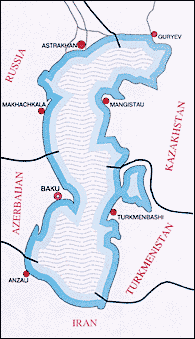 The
Caspian Sea is nearly the size of California and five times larger
than Lake Superior. Its surface, which stretches 746 miles (1200
km) from north to south and 270 miles (430 km) east to west, has
been an important trade route since the Middle Ages.
The
Caspian Sea is nearly the size of California and five times larger
than Lake Superior. Its surface, which stretches 746 miles (1200
km) from north to south and 270 miles (430 km) east to west, has
been an important trade route since the Middle Ages.
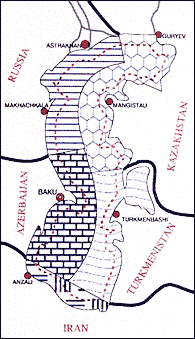 Connoisseurs
know that the Caspian contains some 90 percent of the world's sturgeon
and all the best caviar. Economically, it remains an important trade
route between the littoral states, and the Caspian is resuming its
place as the central link on the "Silk Road" between Europe and
China. The biggest push now, however, is to develop the oil and
gas resources.
Connoisseurs
know that the Caspian contains some 90 percent of the world's sturgeon
and all the best caviar. Economically, it remains an important trade
route between the littoral states, and the Caspian is resuming its
place as the central link on the "Silk Road" between Europe and
China. The biggest push now, however, is to develop the oil and
gas resources.
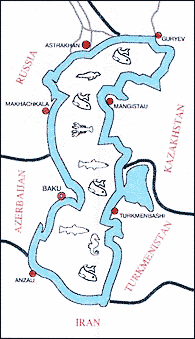 Since
the early 1980s, 135 countries have signed the United Nations' Convention
on the Law of the Sea (UNCLOS). The landmark agreement states that
every nation bordering a sea or ocean may claim 12 miles from shore
as its territorial waters and a 200-mile Exclusive Economic Zone
(EEZ) beyond that. Everything farther out is considered to be the
common property of the world's nations.
Since
the early 1980s, 135 countries have signed the United Nations' Convention
on the Law of the Sea (UNCLOS). The landmark agreement states that
every nation bordering a sea or ocean may claim 12 miles from shore
as its territorial waters and a 200-mile Exclusive Economic Zone
(EEZ) beyond that. Everything farther out is considered to be the
common property of the world's nations.
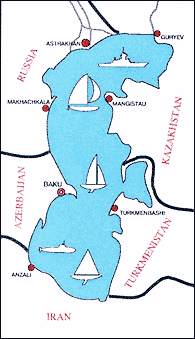 How
a body of water is classified - lake, sea, inland waterway -- can
affect the legal regime that applies to it. The Convention on the
Law of the Sea defines the term "enclosed sea," and customary international
law contains the concept of an "international lake," but here the
law falls short. In the Caspian, history and international law have
created a special case.
How
a body of water is classified - lake, sea, inland waterway -- can
affect the legal regime that applies to it. The Convention on the
Law of the Sea defines the term "enclosed sea," and customary international
law contains the concept of an "international lake," but here the
law falls short. In the Caspian, history and international law have
created a special case.
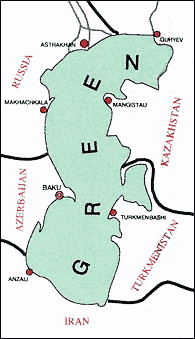 The
history of Caspian policy includes a series of bilateral agreements
between Russia and Iran, and since 1991, between Russia and the
other former Soviet countries. Despite these agreements, the position
of each of the littoral states has continued to evolve. While commentators
often focus on differences between the Caspian states, a more remarkable
fact is the extent to which their positions have begun to converge
since the mid-1990s.
The
history of Caspian policy includes a series of bilateral agreements
between Russia and Iran, and since 1991, between Russia and the
other former Soviet countries. Despite these agreements, the position
of each of the littoral states has continued to evolve. While commentators
often focus on differences between the Caspian states, a more remarkable
fact is the extent to which their positions have begun to converge
since the mid-1990s.